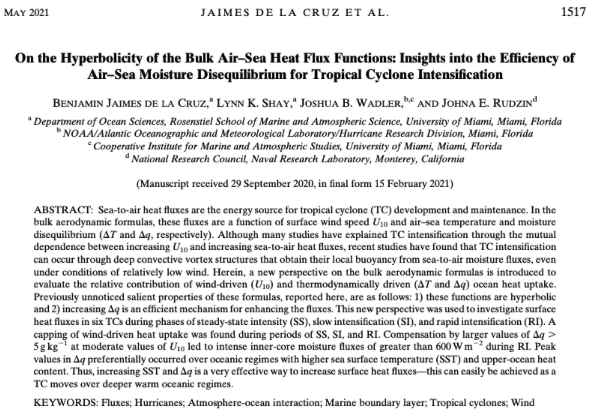Summary: The energy that fuels tropical cyclones comes from the heat and moisture in the warm ocean water below. In a classical theory for tropical cyclone intensification, called Wind Induced Surface Heat Exchange or WISHE, an increase in surface wind speed allows for greater energy transfer from the ocean to the atmosphere (Fig. 1a). This greater energy transfer leads to a stronger storm which leads to an even larger energy transfer. However, additional increases in energy transfer can also occur when the difference between the atmosphere and the ocean is increased. For example, if the humidity is relatively low above the ocean, then more moisture can be transferred from the ocean (Fig. 1b). Similarly, if the difference between the air temperature above the ocean surface and the sea surface temperature is large, then more heat can be transferred from the ocean (Fig. 1c).
Since the relative contributions between WISHE and from energy transfer due to moisture differences between the ocean and atmosphere have not been extensively researched, this study looks at whether increasing the wind speed or increasing the moisture difference between the ocean and atmosphere is more efficient. This new analysis demonstrates overlooked properties of the energy transfer between the ocean and atmosphere which leads to a new way of understanding tropical cyclone intensification. The efficiency of the energy transfer was further evaluated using data from 6 tropical cyclones with different intensification rates.

Important Conclusions:
– In contrast with WISHE, to increase the energy transfer from the ocean to atmosphere at high wind speeds, the difference in moisture between the ocean and atmosphere (either through low humidity in the atmosphere or high sea surface temperature) is more efficient than to increases in the wind speed.
– For the 6 tropical cyclones in the study, ones that underwent significant intensification had higher moisture contrasts between the ocean and atmosphere. For these cases, the higher contrast in humidity between the ocean and atmosphere came from warmer ocean temperatures.
For more information, contact AOML.communications@noaa.gov.
You can read the manuscript at https://journals.ametsoc.org/view/journals/mwre/aop/MWR-D-20-0324.1/MWR-D-20-0324.1.xml. The research team gratefully acknowledges NSF Physical and Dynamic Meteorology/Physical Oceanography for supporting this research (Award Number/FAIN1941498), and NASA (Grant NNX15AG43G).
